|
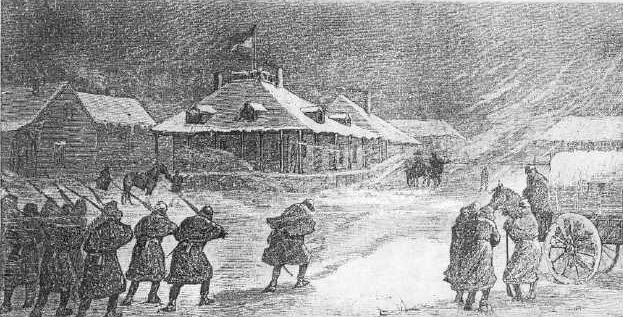
General Crook's Headquarters, Fort Fetterman, Harper's Weekly, 1876
The above woodcut illustrates Fort Fetterman during General George Crook's winter campaign of early 1876 into the
Powder River Country. Compare with photos below. On March 1, 1876, General Crook left Ft. Fetterman with
883 men and a herd of 45 beef cattle. On March 5 the troop ran into a blizzard in which
it was so cold that thermometers did not register and the men while eating had to heat
their forks in the coals of their fires to prevent the tines from freezing to their tongues. Following the Battle of Powder River on March
17, Crook returned to Ft. Fetterman.
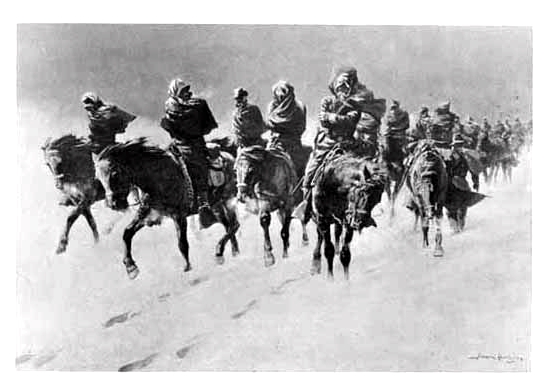
"Thirty Below and a Blizzard Raging," Frederic Remmington, McClure's Magazine, June 1899
George Crook (1830*-1890) graduated near the bottom of his class at West Point in 1852.
[*Writer's note: various sources give Crook's date of birth as Sept. 8, 1828, 1829, and 1830. The P.B.S.
website, The West gives his date of birth as 1828. His grave marker in
Arlington National Cemetery shows 1830.] Crook saw duty during the Civil War at
Second Manassas [Second Bull Run], Chichamauga, and in the Shenandoah Valley, including
Cedar Creek.
[Writer's personal note: My wife's great-grandparents' family farm was
on Cedar Creek Battlefield. The house was used during the battle as a hospital.
Thus, my mother-in-law had strong feelings, and when she learned that we were to be married, had a
spell of the "vapors," and told my wife, "Oh, to think of grandfather's sword --
who fought under Imboden under Stonewall Jackson -- hanging on a Yankee's mantle." Guess where that
sword is now hanging. John D. Imboden (1823-1895), a lawyer, was commissioned as
a Brigadier General in 1863 and commanded the Department of the Valley, and after the
death of Stonewall Jackson, had primary responsibility for the defense of the
Shenadoah Valley against Crook.]
Among those serving under Crook was Rutherford B. Hayes. Crook was
subsequently captured by Confederate forces and held in Richmond for a short period
before he was exchanged.
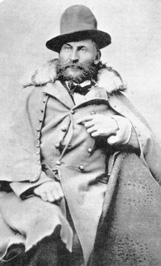
General George Crook, note wolfskin collar.
In 1871 Crook was assigned to Arizona. He was transferred to
the northern plains in 1875. In 1882, Crook was reassigned to Arizona where he engaged
in the search for Geronimo until 1886 when he was relieved of command and replaced by
Nelson A. Miles. For the remainder of his military career he fought for the
release of Apache scouts who had faithfully served under him in Arizona and were
rewarded for their efforts by bing imprisoned in Fort Marion (now Castillo de San Marcos) in
St. Augustine, Florida or in Fort Pickens, Pensacola, Florida. After being relieved of command in
Arizona, Crook served as Commander of the Department of the Platte until 1888 when he was
given command of the Department of the Missouri where he served until his death in 1890. Upon learning of Crook's death,
Red Cloud, Makhpiya-Luta (1822-1909), said: "Crook never lied to us. His words gave the people hope. He died. Their hope died again."
The same thought was echoed by Crook's aide de camp, John G. Bourke, who noted:
"If there was one point in his character which shone more resplendent
than any other, it was his absolute integrity in his dealings with
representatives of inferior races: he was not content with telling the
truth, he was careful to see that the interpretation had been so made
that the Indians understood every word and grasped every idea..."
[Writer's note: Some have observed that the reference to "inferior"
was not intended as being racist as evidencing a prejudice against Indians,
but was more paternalistic, in the sense that it
was the duty of the white man to bring civilization to others through the
reservation system and schools similar to Carlisle. Until fully civilized,
the Indians were more like children
to be educated and protected by the Great Father in Washington or the Great Mother in London.]
Former President Hayes served
as one of Gen. Crook's pallbearers.
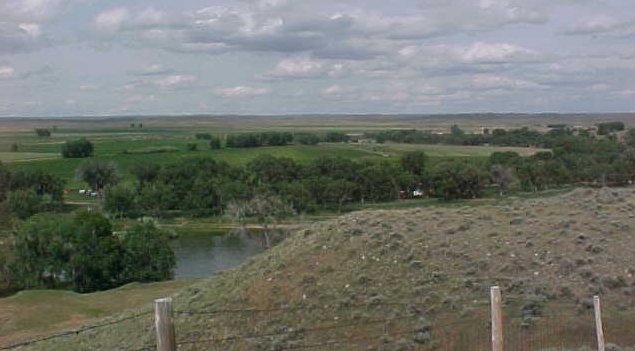
Looking Northeast from Ft. Fetterman, 2001, Photo by Geoff Dobson
Gen. Crook's camp at Ft. Fetterman was located on the field on the far side of the Platte River toward
the center of the above photo. From here on May 29, 1876, he set forth toward the
former site of Ft. Reno with 1,000 cavalry and infantry enlisted men, 50
officers, and 262 Crow and Shoshoni scouts.
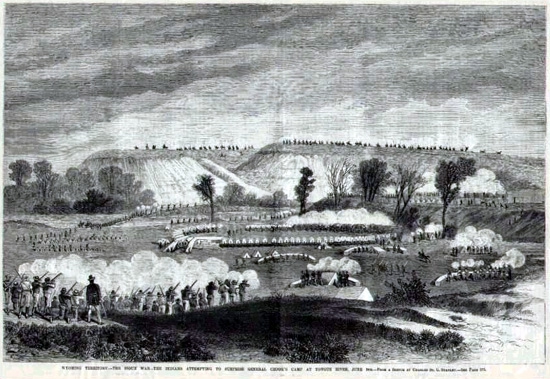
Wyoming Territory--The Sioux War --
The Indians Attempting to Surprise General Crook's Camp at Tongue River, June 9th, sketch by Charles St. G.
Stanley, Leslie's Illustrated News, 1876.
The encounter at Tongue River consisted of an attack by about 200 Northern Cheyenne under
Little Hawk. Earlier in the day, the soldiers relaxed by horse racing. The races were ended when
a bullet fired from across the river hit Capt. Andrew Burt's horse in the leg. The horse had
just won its race. The total casualties were two Indians killed or wounded, the wound to
Capt. Burt's horse, a wound to Lt. Robertson's horse, one mule killed, and
two soldiers with contusions from spent bullets.
By June 12, Crook had reached
Clear Creek near the present site of Buffalo. From there he proceeded up to the confluence of
Big and Little Goose Creeks at present day Sheridan. Because they would slow him down, Crook left his
wagons and ambulances behind at Goose Creek.
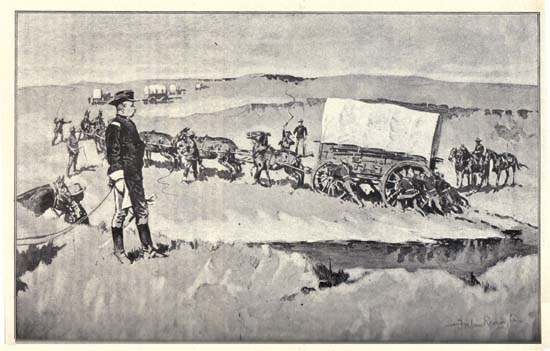
"A Government Six Mired Down," Frederic Remmington
On June 14, 176 Crow and
86 Shoshoni under Chief Washakie joined Crook's forces. A reporter for the
New York Herald, described the Shoshoni:
[N]early every Shoshone in going to war, carries a long white wand
ornamented with pennants or streamers of fur, hair and red cloth.
They wear parti-colored blankets, and ride usually either white or spotted
ponies, whose tails and manes they daub with red or orange paint.
Nothing could be more bright and picturesque than the whole body of
friendly Indians as they galloped by the long column of the expedition
early in the first morning of the march, as it wound around the base
of the low foot hills called the Chetish or Wolf Mountains, which
were traversed in moving toward the head waters of Rosebud Creek. Several
of the Snakes still carry their ancient spears and round shields of
buffalo horn and elk hide, besides their modern firearms.
Unbeknowst to Crook a large force of Northern Cheyenne and Sioux awaited at
Rosebud forewarned of Crook's approach by Little Hawk's encounter at Tongue River.
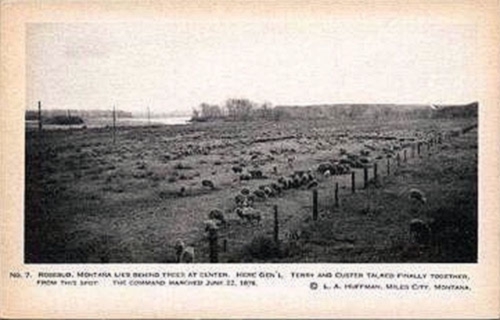
Site of the Battle of the Rosebud, L. A. Huffman, 1918
On June 17, the Company was
surprised by Indians at the Rosebud just north of the Wyoming Line, resulting in
Crook's withdrawal back to the Tongue River. At the Rosebud Crook encountered
some 1,500 Indians. Crook's casualties were nine killed and 19 wounded including one soldier
who accidently shot himself. Crook had left his wagons behind at Goose Creek.
Thus, the wounded had to be evacuated riding their own horses or be brought out on
travois. One who was brought out by travois was Capt. Guy V. Henry (1839-1899). Capt. Henry in an article
in Harper's Weekly, July 7, 1895, "Adventures of American Army and
Navy Officers; Wounded in an Indian Fight," recalled:
I felt a sharp sting as of being slapped in the face, and a blinding rush
of blook to my head and eyes. A rifle bullet had struck me in the face,
under my left eye, passing through the upper part of my mouth, under the nose, and
out below the right eye. I retained my saddle for a moment, then dismounted and
lay on the ground. The Sioux in their desperate charge actually passed over me and
had it not been for Washakie, chief of the Shoshones, fighting over my body; my
scalp would have been lifted.
Captain Henry in his article was, perhaps unduly modest.There was but scant medical attention available. Henry was blinded. For the whole day, according to
Cyrus Townsend Brady, "What They Are There For," Harper's, Vol. XXXIv, p. 409, Henry was required to lie on the
ground in the heat, with little water, and "practically left to die." His only shade was that of a restive horse.
When battle was over, the travois was made of two saplings and suspended between two mules. As Capt. Henry was being evacuated, the mules carrying the travois shied, throwing
Capt. Henry off the conveyance twenty feet down a ravine. Nevertheless, the
captain pronounced himself "bully." He realy wasn't "bully." The poles of the travois were short and several times on the two hundred miles back to Fetterman,
he was hit in the head by the head of the rear-most mule. Finally, Henry was turned about, his head forward with the risk, of course, of
being kicked to death by the forward mule. At Fetterman, the Platte had to be crossed on a cable ferry. Unfortunately,
the river was running high and as Henry was being prepared for loading on the ferry, the ropes broke and the ferry was dashed
to pieces. He was ultimately taken across in a small skiff. Finally, sufficient troops became available for an
escort to the railroad at Medicine Bow. It was the Fourth of July, celebrated by the cowboys and citizens by the firing of
six guns. Two bullets passed through Henry's tent just above his head. As the train passed over
Sherman Hill, the combination of the elevation and the chloral and other medicines almost killed him. It took over a year for
Henry to recovery sufficiently for active duty. Following the battle, Henry was brevetted as a
brigadier general. During the Spanish American War, Henry was promoted to major general.
The Battle of the Rosebud is regarded as
an Indian victory. Some contend that Crook's failure to advise of the
strength of Indian forces was one of the causes of the loss by
Custer eight days later at the Little Big Horn or Greasy Grass.
Next page: The Battle of the Little Bighorn.
|